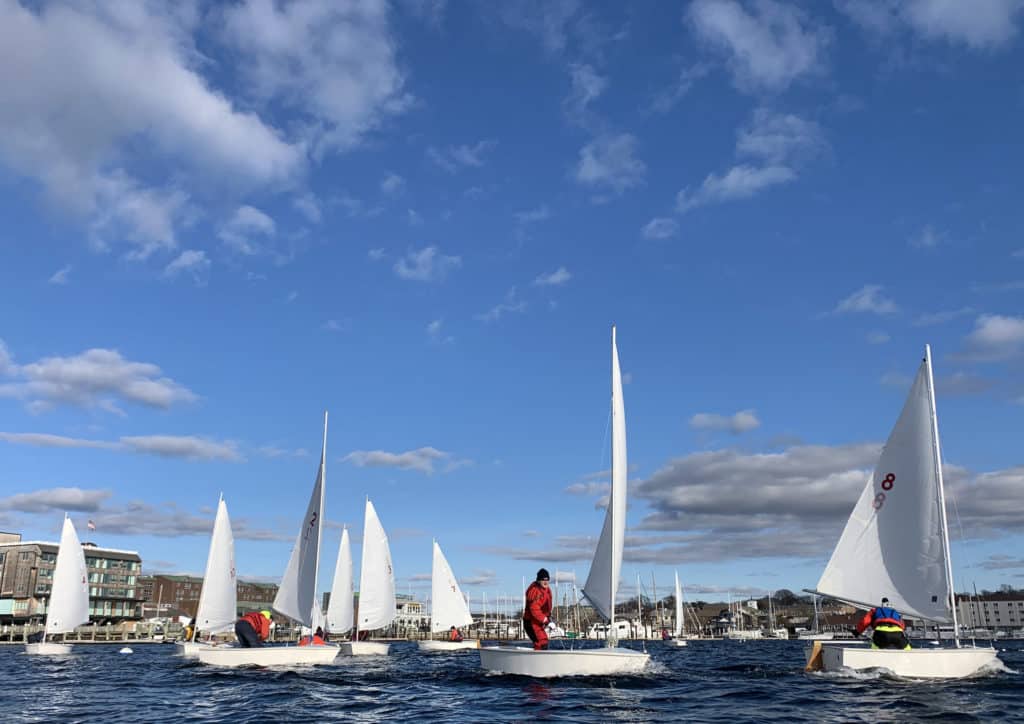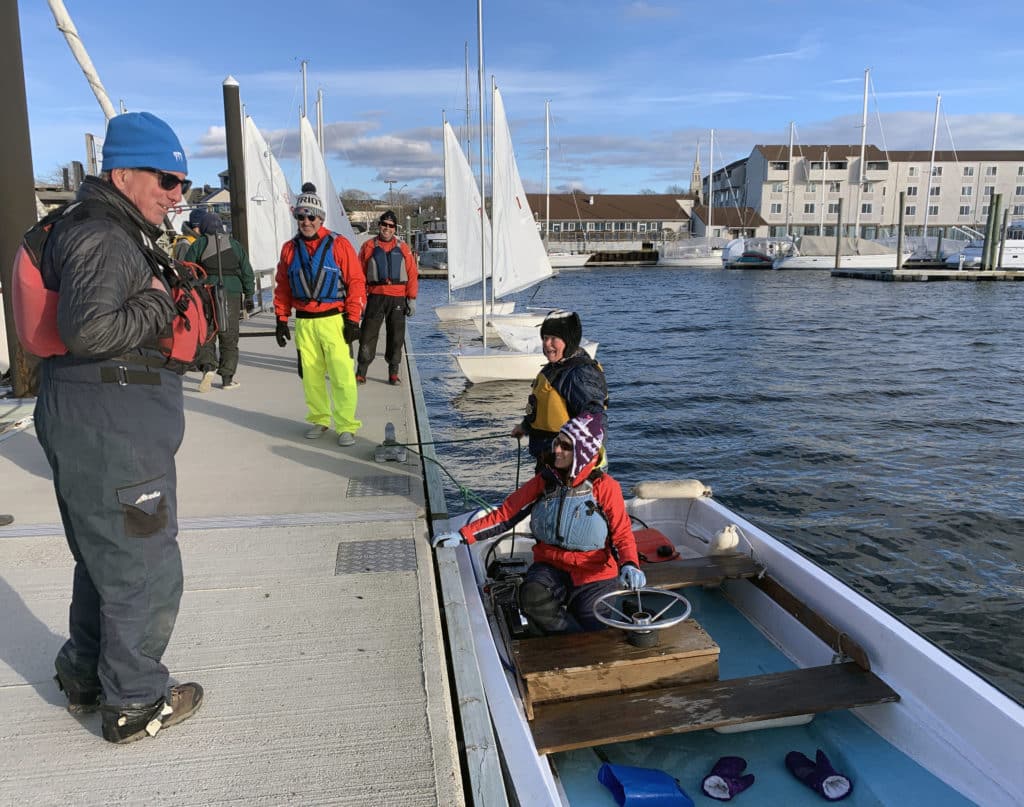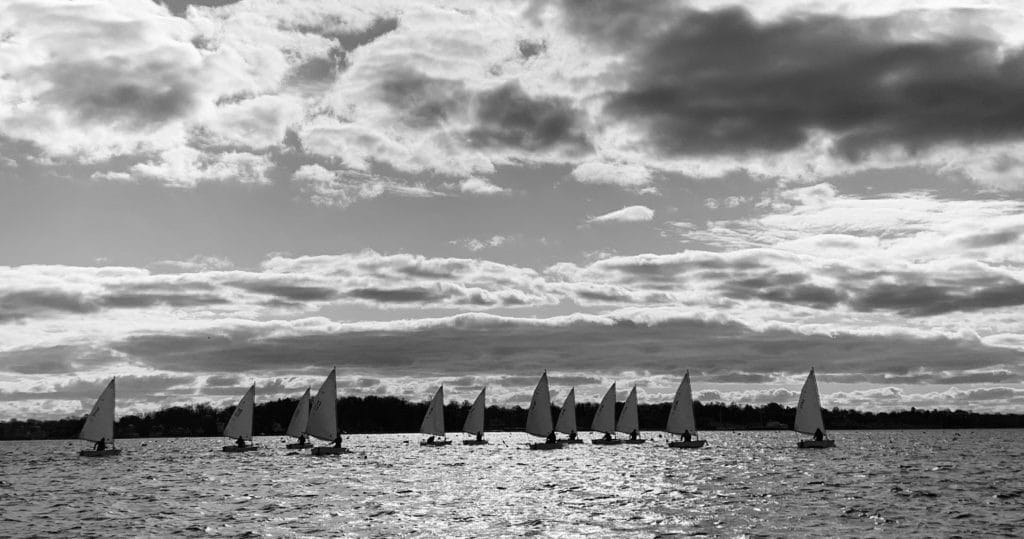
I knew someone would eventually give me the business. Lo and behold, it turned out to be my former Senior Editor, Stuart Streuli. After I texted him a picture of a printout of Newport Yacht Club’s “Frostbite Results 1/1/20,” he fired back a series of questions: “Did you demote yourself to Turnabouts? You won every race? Shouldn’t you retire?”
Yes, Stu, I’m racing Turnabouts, the pudgy flat-bottoms tubs I’d learned to sail in as kid. And, yes, I did win every race. Retire? No way, man. I’ve never felt younger than I did that first crisp and sunny afternoon of the Newport Yacht Club Frostbite Season.
As to winning every race, well, there’s more to the story, which I’ll get to momentarily.
There are two winter racing options in Newport. Laser Fleet 413 plays in the south end of the harbor. The usual suspects are rabid and extremely good. Most have expertly tuned and rigged boats with carbon top sections and fresh sails. Strong hiking legs and a good handle on the rules are required to do well of course.
I’ve sailed with Fleet 413 on off for the past 20 years, Stu and I were even fleet captains for a while. I maybe won a race or two over the years, but today my boat, 157957, is no longer adequate, barely competitive and leaky. My one blown-out race sail would be better served as a drop cloth. My memories of Fleet 413 are a mix of thrilling surfs down icy waves and the burn of my fingertips to point of real and lasting damage. Don’t get me wrong: It was always fun, even when I finished last or tumble-weeded around the jibe mark of the triangle racecourse. But the wet, bone-chilling cold made a liar out of me: I kept telling myself it’s what I had to do to keep sharp whatever declining dinghy skills I had.

Every once in a while, especially those days with a raw northwesterly, I’d look longingly to opposite side of the harbor and admire the cruisy Turnabouts doing their thing in the lee of Newport Yacht Club, up where the harbor is flat and protected from the full bite the arctic gradient. I’d often wonder why I was torturing my body and mind. For what gain other than a full-body hangover and some terrible results.
With my Laser resting on sawhorses in my front yard, its white hull a light shade of algae green, October comes around and I make my decision. It’s time go to play with the Turnabouts. Like the aging shortboard surfer who succumbs to using a longboard, or worse, a SUP, there’s a tinge of shame that lingers after I submit my online registration and pay the $200 season fee. I’m now a kook, a has-been from Fleet 413.
“I hear Dave turned Turnabouts,” they might say. “What a wimp.”
But, hey. Racing is racing, right? And when I tell my wife I’ve signed up for the series—so, for the record, I will be gone every Sunday—she responds, saying, “Good. You’ve been talking about it long enough.”
New Year’s Day is opening day for Newport YC’s Frostbite and it comes with a clear blue sky and a westerly that roared in overnight. The sun is big and low when I arrive at the club and the empty harbor is a sparkling playground. Gust stripes snake east to west and whistle through the rig of winterized boats still in their slips. The toasty clubhouse is bustling with the 10:30 brunch seating, and the sweet, cheery and grandmotherly fleet captain, Winkle Kelley is maintaining vigil on the anemometer. We’re on the edge of the fleet’s “20:20” rule. If air temperatures are below 20 degrees: it’s a no go. If wind speeds are sustained over 20 knots, admire the view. It’s 35:20 when I arrive, but a dozen Turnabouts are being rigged by fleet members, an operation led by FJ Ritt, the reigning (and nine-time) Frostbite champion.

Ritt has primped the 20-year-old fiberglass boats for another year of competition. He’s “taken the shark bites” out of the wooden rudders, replaced frayed ropes, and rigged the boat’s only controls: centerboard, cunningham, traveler and vang.
I corner him on the dock and introduce myself, not letting him on to the fact that I’ve done my research and know he’s the first one to hit up for tuning and boathandling tips. The Turnabout (now officially called N10) are unique to the Northeast. It’s an everlasting design for puttering about and teaching sailing. They’re fat, hard chinned, and ungraceful. Ritt describes it as, “a box with a bow.”
But they’re sinkers, too, prone to submarining or taking on water when the gunwale is buried.
When I ask Ritt for a few go-fast pointers he doesn’t offer much to this stranger. Instead, he warns me about the boat’s tendency to get stuck in irons. “Don’t try to shoot the weather mark,” he says. “It never works. And don’t shoot the pin, especially.”
Duly noted.
With that, I wander about, introducing myself to whom I assume are the regulars, and try to find out what I can about how the racing works. According to the sailing instructions: there are 12 boats, and if there are 24 sailors, there’s an A and a B fleet. Placement is determined by previous results or demonstrated ability. When A races, B conducts the races, and vice versa until the sun goes down. Before a race, I’m supposed to draw a boat number from a bag. No one sails the same boat more than once per day.
As a newcomer, under the fleet rules, I’m required to race in the B fleet and I’m fine with that. I know a few B-fleet faces, both are first-timers, too. One of them is a fellow Fleet 413 deserter, and one a former Sailing World staffer.
Ritt eventually conducts the official skippers meeting, a group of 29 sailors huddled on the club’s front porch. He covers the basics, warns everyone about the head-to-wind-thing, and explains what to do should anyone sink or become disabled: the race stops immediately and everyone returns to the dock. I make a mental note to not to be that guy.
Once the meeting is wrapped, I help A fleet sailors cast off docklines, wish them well, and then take a place among the B-fleeters, dressed in layers and observing the race from the porch. A white-haired fellow named Paul Fleming, fourth overall in 2019, wins the first race easily. I’ll have to keep an eye on him.
The A fleeters return to the dock for the day’s first rotation and I step gingerly into boat No. 7. I’ve drawn the lucky one. I drift back, get my balance, turn the bow onto to a reach, sheet in the mainsail, and sit on the rail, hiking against the blown-out Dacron sail. Water splashes over the bow, so I slide my butt aft a few inches. It’s been 40 years or so since I learned to sail in a Turnabout, and corny as it sounds, it instantly feels familiar. It’s not fast by any stretch, but it glides across the short chop. The winter sun warms my cheeks. It feels so good to be back.
I try a few roll tacks and they’re pretty smooth. I’m confident, but I’m also edgy, as if I have something to prove to myself and the rest of my B fleeters. Sure, I’m out here to feel the wind and sun on my face on a Sunday afternoon in January, but I’m also out here to win races. That is the point, after all.
At the bitter end of three minutes of signals, however, I’m early, exposed, and running out starting line. I bail before the inevitable OCS, round the pin, jibe clumsily and sail through a parade of transoms. With the benefit of clear air and the fleet herding out to the left side, however, I have an open racecourse to tack on the shifts as I please. I’m second at the weather mark, I take the lead at the leeward mark, and sail the second beat with a lump in my through. Am I actually winning this race? I will find a way to screw up, I’m sure. Capsize and sink? Get stuck in irons?
The late Dr. Stuart Walker would understand if I did something stupid in this moment. I’m sure there’s a chapter about this somewhere in his mind-bending book, Code of Competition. But I calm my nerves on the final run, the nearest boat is 50 feet behind, and sail past the race committee recording finishes off a dock in front of the club. There’s no clapping, no cheering, no atta boy. But someone does say, “That’ll get you to the A fleet.”
After the rotation, I join Ritt in the Boston Whaler crash boat. He’s sitting out today to ensure the opening day goes smoothly. I learn he’s retired, joined the club seven years ago, and recently bought a J/35 and has a mild case of buyer’s remorse. He points a few A fleet hot shots. I take mental notes.
My second start is no better. I’ve timed my approach Vanderbilt style and I’m exactly where I want to be at 10 seconds, but there’s a guy to weather. I could easily luff and clear him out, but I have no intentions of being an aggressive, bossy and loudmouth rules pusher on Day 1. Consequently, I’m buried, I’m slow, and I’m starting to panic.
I can imagine the headline: “Guy Wins Race, Sucks in Next.”
I clear out when I can safely duck a few transoms, but tack back to starboard soon after to stay with the herd. To my amazement, the fleet is below me. I’m free, work the shifts and can hardly believe my luck when I win the second one. It was “uncontested,” Ritt says with a chuckle afterward, before warning me, “A fleet is going to be a lot harder next week.”
He’s right. I observe their second race closely, and there’s serious boat-to-boat combat around the marks.
I almost get caught out barging in my third-start, but I bail out in time, jibe quickly and start a few seconds late. Again, within a minute, the entire fleet is leeward and I’m out front the entire race, loosely covering the followers. Never in my life have I ever put up a picket fence and it sure is a confidence booster. A great way to start the year.
After flaking sails by the warmth of the fireplace (a community affair), I’m brimming with a smug satisfaction, wondering why I’d taken so long to make the switch to this far more civilized version of frostbite sailing. Yes, Stu. Turnabouts, God damn it. I’ve made the right decision because winter sailing, in any form, warms the soul.
Now, on to the A fleet I go for what I suspect will be some warm humble pie.









